It’s December, and you discover that your team has been underperforming since April.
Sounds ridiculous, right?
That’s exactly what delayed feedback does: it hides the truth until it’s too late to fix.
I’ve spent the last 10 years helping HR leaders and team managers build feedback systems that work in real time. After consulting with over 300 companies and analyzing 12,000+ feedback cycles, I’ve seen what works, what fails, and what scales.
So, in this blog, I will help you understand:
- What continuous feedback really looks like (and why it matters)
- How to deliver it consistently without burning out
- Which tools and steps will help you lead with confidence
By the end, you’ll know how to turn feedback into a habit that drives real performance and retention. Let’s get started.
What Is Continuous Feedback?
Continuous feedback, also known as ongoing feedback, is a structured yet ongoing approach to giving performance input regularly throughout the year, not just during formal review cycles. Instead of waiting for an annual review to address issues or recognize progress, managers use frequent conversations to guide, support, and develop their team in real time.
And it’s not just a nice-to-have. According to a study, employees who receive daily feedback from their manager are 3.6 times more likely to be engaged at work.
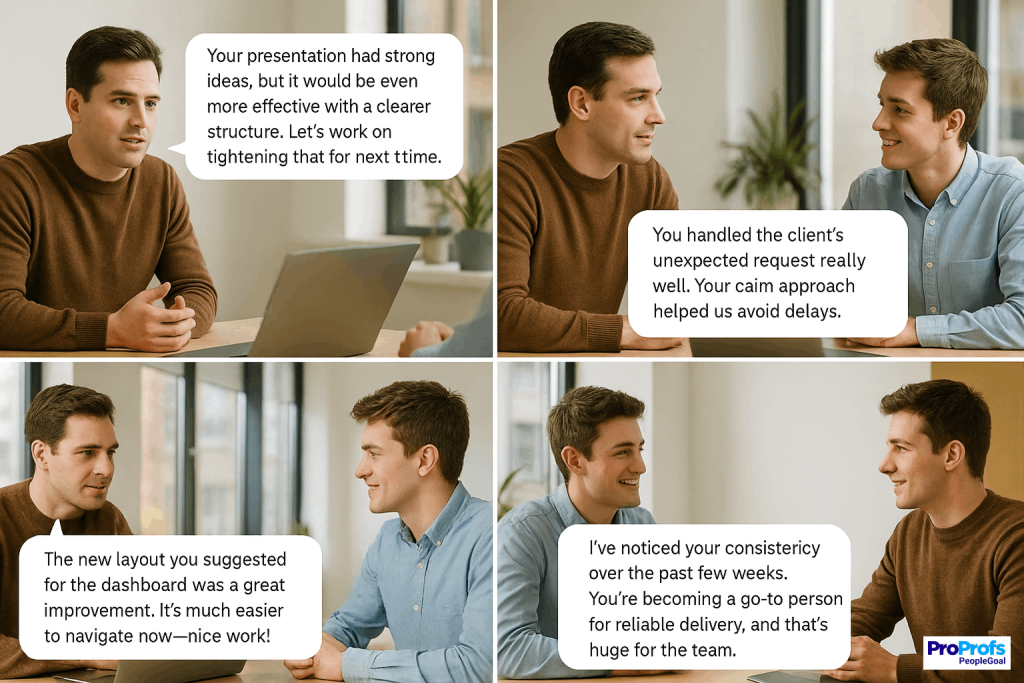
For example, let’s say a sales manager notices that one rep is great at building rapport but often skips follow-up emails. Rather than waiting months, they bring it up after the next call: “Great conversation—next time, let’s ensure the recap email goes out the same day. It boosts conversion.” The process is adjusted immediately, and the employee’s performance improves within a week.
That’s continuous feedback; timely, specific, and geared for real growth, not delayed corrections.
Here’s a quick video to understand things better:
Now, let’s know the major differences between annual reviews and continuous feedback.
Annual Reviews vs. Continuous Feedback: Why One Belongs in the Past
If you’ve ever sat through an annual review thinking, “Why didn’t I hear this months ago?” you’re not alone. I’ve worked with enough teams to know that traditional reviews are often too late, too stiff, and too disconnected from actual performance.
And if you’re a manager, chances are you’ve also dreaded cramming 12 months of feedback into a one-hour meeting, trying not to forget anything or anyone.
Let me be clear: annual reviews aren’t entirely useless. But they are not enough, especially if you want agility, clarity, and stronger relationships. That’s where continuous feedback outperforms in every way that matters.
Here’s a side-by-side breakdown of what you’re really choosing between:
| Aspect | Annual Review | Continuous Feedback |
|---|---|---|
| Frequency | Once a year, often rushed and delayed | Weekly, bi-weekly, or monthly, depending on team needs |
| Timing | Feedback is retrospective and often outdated | Feedback is timely and tied closely to actual events |
| Purpose | Used primarily for evaluation and formal records | Focused on employee development, improvement, and recognition |
| Tone | Formal, sometimes tense, or overly scripted | Conversational, constructive, and future-oriented |
| Engagement Impact | Often lowers motivation and causes stress | Increases motivation and clarity; daily feedback improves engagement 3.6 times |
| Bias Risk | High, due to memory gaps or recency bias | Reduced, as feedback is based on consistent observation |
| Manager Effort | Heavy workload all at once during review season | Lighter, manageable input shared across the year |
| Employee Clarity | Creates long periods of uncertainty | Promotes constant alignment and fewer surprises |
| Adaptability | Inflexible and slow to respond to changes | Adjusts quickly to new goals or shifting priorities |
| Impact on Performance | Often, it’s too late to correct problems effectively | Promotes faster learning and stronger results over time |
Now that you’ve seen how continuous feedback compares to the old-school annual review, let’s explore what’s really driving managers and HR professionals to adopt it in the first place.
What Managers & HR Want From Continuous Feedback
If you’re leading a team or responsible for performance across the organization, you’re not giving feedback just to be nice. You’re doing it to get results, to elevate performance, keep your best people, and build a workplace where clarity replaces confusion.
Here’s what I consistently see leaders aiming for when they adopt continuous feedback:
- Better Performance at the Individual Level: You want employees to improve in real time, not months after mistakes have piled up. Frequent feedback gives them course correction while it still matters.
- Stronger Retention: According to LinkedIn, 69 percent of employees say they’d work harder if their efforts were better recognized. Continuous feedback helps you catch and reward wins before people feel overlooked.
- Faster Skill Development: When you correct behavior or reinforce good habits as they happen, you speed up learning. This is especially valuable for new hires or employees stepping into bigger roles.
- Aligned and Accountable Teams: Feedback keeps everyone tethered to the same objectives. You don’t want goals collecting dust until review season; you want everyone rowing in sync now.
- A Culture of Openness and Trust: You’re probably tired of managers avoiding tough conversations or only giving feedback when something goes wrong. Continuous feedback creates a rhythm where praise, coaching, and problem-solving are part of everyday work.
Bottom line: Continuous feedback isn’t just about improving your people. It’s also about improving your culture, your results, and your ability to lead with confidence.
Here’s a quick video on how to enable a feedback culture:
Great. Now that we know what managers and HR leaders want from continuous feedback, let’s get practical and look at the actual types of feedback you can give and how to do it right.
Types of Continuous Feedback (Examples & Templates)
You’re not stuck with just one approach. In fact, the most effective managers use multiple types of feedback, each tailored to the situation and the employee’s needs.
Here are five types of continuous feedback that I’ve seen work across organizations, from startups to enterprises, and exactly how you can apply them with confidence.
1. Real-Time Coaching Feedback
This type of feedback happens immediately after a task, meeting, or behavior that needs adjustment. The focus here is on improvement, addressing something in the moment while it’s still fresh, without waiting for a formal review.
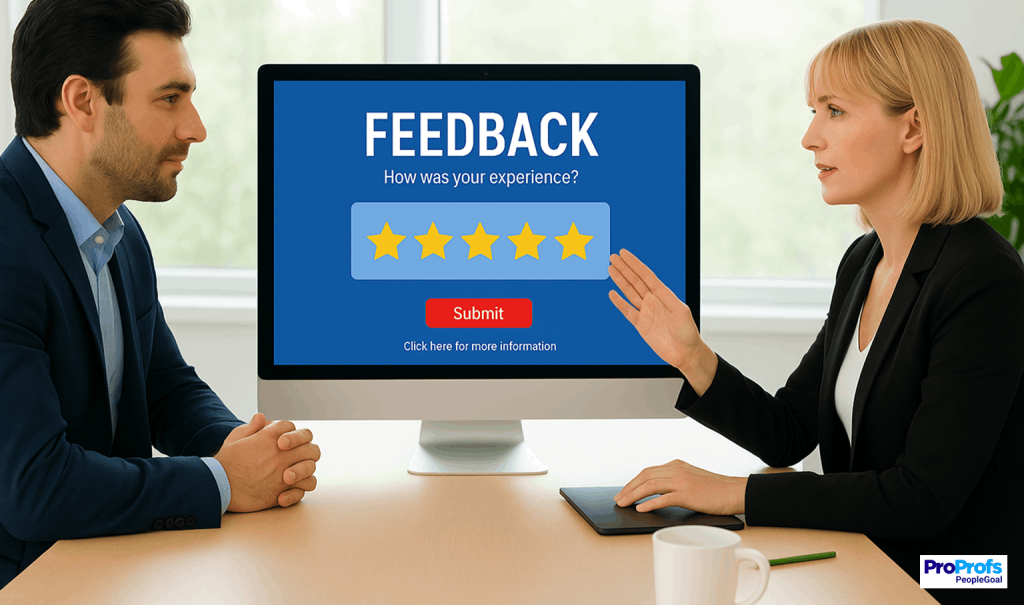
You’re not scolding.
You’re helping your team member see a better way forward while they still remember the situation clearly. It works because the details are still sharp for both of you, and it creates a rhythm of course-correction that feels normal, not confrontational.
For example, let’s say your marketing associate just finished a webinar presentation. The event went smoothly overall, but they skipped over the demo section that the audience was clearly expecting.
After the session, you take five minutes to debrief with them. You point out that their slides were clean and their pacing was great, but skipping the demo probably left attendees wanting more. Together, you agree that for the next webinar, they’ll prioritize demo timing in the dry run and rehearse transitions more deliberately.
Template:
“Let’s take a few minutes to unpack how [specific event or task] went.
One thing I appreciated was [something they did well], because it [specific impact]. One thing we can improve is [clear behavior or action], since it affected [result, audience, or goal].
For next time, let’s focus on [new behavior or strategy] so we get closer to [intended outcome]. I’m confident you can adjust quickly, and I’ll support you however you need.”
2. Positive Reinforcement and Recognition
Positive feedback is often overlooked because it seems obvious. But if you want high-performing teams, you need to make positive reinforcement intentional and consistent. Recognizing small wins, consistent effort, and values-driven behaviors helps your team feel seen and more likely to repeat what’s working.
The key is to be specific, timely, and connect praise to impact or values. “Great job” is nice. “Your solution helped us hit the deadline without overtime” is powerful.
Let’s say one of your engineers refactored part of the product codebase in their own time, which made it faster for everyone else to deploy changes. No one asked them to do it. They just saw the problem and fixed it.
Rather than waiting for the next team meeting to say thanks, you take a moment that same afternoon to acknowledge their initiative and explain how it unblocked the team.
Template:
“I want to call out what you did on [specific situation or task]. The way you [describe action taken] had a clear impact—it [describe benefit or result]. That’s exactly the kind of ownership and initiative that makes a difference for the team.
Your effort didn’t go unnoticed, and it speaks volumes about your commitment to our goals. Keep bringing that mindset; it lifts the whole team.”
3. Goal-Oriented Progress Feedback
This feedback keeps employees focused on the right objectives and ensures they’re not drifting off course. It’s especially useful during ongoing projects, quarterly goal check-ins, or when you notice misalignment in priorities.
You’re not waiting until the end to evaluate success; you’re using feedback to influence success as it’s unfolding. The idea is to keep the conversation about goals dynamic and responsive, not static.
For example, imagine your customer success manager is responsible for reducing churn for mid-size accounts this quarter. A month in, you notice that their efforts have been spread across all account tiers, diluting impact.
During your next one-on-one, you revisit the original focus and ask what’s made it difficult to stay narrow. Together, you agree on a sharper prioritization strategy and set specific checkpoints for tracking mid-size renewals only.
Template:
“We’re partway through our timeline for [specific goal], and I’ve noticed some patterns that are worth checking in on. Originally, we set out to [goal], but I’m seeing energy going toward [off-goal effort]. Let’s realign and figure out where things might be drifting.
What’s made it tough to stay focused so far?
What’s working?
My goal is to help you make the most impact with your time, so let’s clarify priorities and agree on next steps that bring us back into alignment. We’ll check in again on [date/time] to track progress.”
4. Peer and Upward Feedback
This type of feedback includes insights that come from outside the manager-employee relationship. Peer-to-peer and upward feedback help create a workplace where learning and accountability are shared.

As a manager, your role is to encourage this kind of cross-directional employee feedback and amplify it when it’s valuable. You can use it to reinforce collaboration, pass along praise, or surface coaching opportunities based on how others experience your employee’s work.
Suppose your team’s project coordinator receives unsolicited praise from a senior stakeholder who was impressed with their organization and follow-through.
You don’t keep that praise to yourself; you pass it along directly. In doing so, you reinforce the behaviors that led to it and signal to the employee that their contributions are visible beyond the team.
Template:
“I wanted to share something that came up in a conversation with [person or team]. They specifically mentioned that you [describe behavior or outcome], and it made a strong impression.
That kind of feedback doesn’t happen accidentally; it comes from how consistently you show up. I wanted to make sure you heard it directly and knew that your work is making a real impact across the organization.
If you’re open to it, I’d also love to see how we can help you build on this momentum moving forward.”
5. Sentiment and Well-Being Feedback
Not all feedback is about performance. Sometimes, you need to check in on how someone is feeling, especially if they’ve gone quiet, their mood has changed, or you sense burnout creeping in.
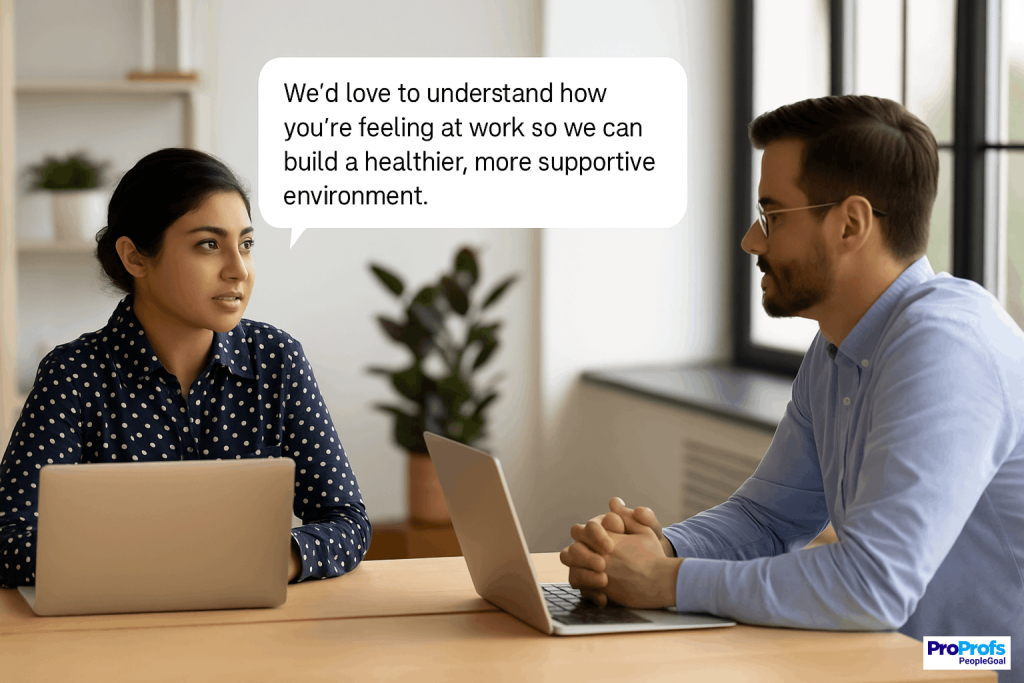
This type of feedback is about opening a dialogue that allows employees to express concerns, frustrations, or even confusion before those feelings affect their work. It’s preventive care for your team.
Let’s say your most dependable team member has been missing deadlines recently, which is out of character. You pull them into a private one-on-one and let them know you’ve noticed the change.
You approach it with curiosity and care, not assumption. The employee opens up that they’ve been overwhelmed managing home responsibilities on top of work. Together, you discuss adjustments and support options that allow them to recalibrate.
Template:
“I’ve noticed a shift lately in how things have been going for you, and I just want to check in, not to add pressure, but to make sure you feel supported. You’ve consistently delivered strong results, which makes me think something might be weighing on you more than usual.
If there’s anything affecting your capacity, let’s talk it through. We can figure out where to dial things back, get support, or adjust timelines if needed.
I want you to succeed here, and part of that is making sure the foundation you’re working from is sustainable.”
Sounds good?
Okay, great!
Now that you’ve got a clear picture of the types of continuous feedback and how to deliver them, let’s address the part no one likes to admit: Even with the best intentions, continuous feedback can go wrong.
And when it does, it’s usually for reasons that are easy to spot, if you know what to look for.
Why Continuous Feedback Fails (And How to Fix It)
I’ve seen feedback programs launch with energy and optimism, only to fall apart a few months later. It’s not because the idea was bad. It’s because no one prepared for the real-world obstacles of changing how people communicate, lead, and manage performance.
If any of the issues below sound familiar, you’re definitely not alone, and more importantly, they’re all fixable.
It’s Inconsistent and Gets Deprioritized
Managers start off strong, but one busy week turns into two, and suddenly the feedback loop goes cold. When one-on-ones get pushed aside or feedback is “saved for later,” you lose trust and momentum. Employees start to wonder if the system was real or just a short-term initiative.
Quick Fix: Build feedback into existing employee workflows and calendars. Treat check-ins like non-negotiable meetings, not optional extras. If needed, use recurring templates or reminders to keep conversations consistent.
Feedback Feels One-Sided or Top-Down
Here’s an example of such feedback:
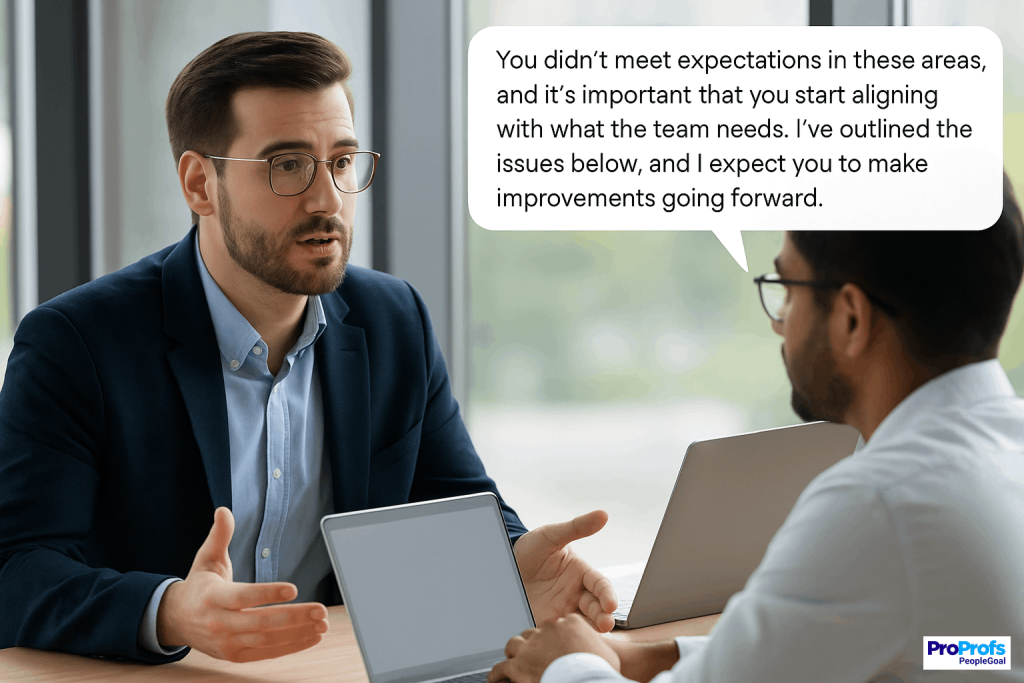
When feedback only flows from manager to employee, it starts to feel like surveillance instead of support. Employees may disengage or hesitate to speak up if they never get to give feedback themselves.
Quick Fix: Encourage two-way feedback. Ask your team for input on your own leadership and invite feedback on team dynamics, tools, or processes. This creates a culture of conversation, not command.
Managers Aren’t Trained to Give Feedback Well
You can’t expect quality feedback if managers haven’t been taught how to give it. Vague or overly critical comments do more harm than good. I’ve seen managers say “You just need to be better at communication” without providing context or a single example—and then wonder why nothing changes.
Quick Fix: Provide training and coaching for your managers. Give them frameworks, real scenarios to practice, and examples of strong vs. weak feedback. Feedback is a skill, not an instinct.
Feedback Becomes Overwhelming or Constant
Too much feedback can backfire. If employees feel like they’re being corrected every other day, they may burn out, tune out, or feel like they’re under a microscope, even if your intentions are good.
Quick Fix: Focus on meaningful moments, not micromanagement. Prioritize feedback based on what will drive performance or growth. If everything’s urgent, nothing is.
It Lacks Follow-Up or Tracking
Giving feedback without following up is like planting seeds and forgetting to water them. If you never revisit what you suggested or recognize progress, the employee may think it wasn’t important, or worse, that you didn’t mean it.
Here’s an example:
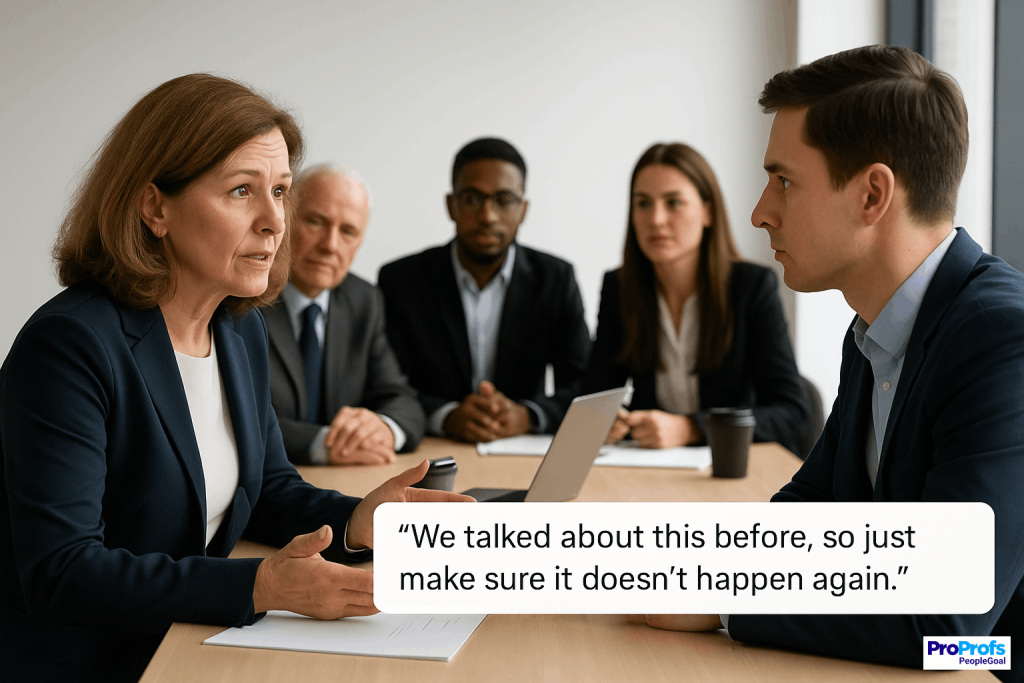
Quick Fix: Make feedback a cycle, not a single moment. Use your next check-in to ask, “How did that go?” or “Any progress on what we discussed last time?” Small follow-ups build accountability and show that your input matters.
The Culture Doesn’t Support Open Dialogue
Even if your feedback process is solid, it won’t stick in a culture where people are afraid to be honest. If employees worry about retaliation, embarrassment, or being judged, they’ll either hide problems or ignore the feedback they get.
Quick Fix: Create psychological safety through transparency and example. Model the kind of feedback behavior you want to see, share your own development openly, and reward honesty over perfection.
Now, here’s something important:
These issues don’t mean you should avoid continuous feedback. They just mean it needs the right structure, training, and culture to thrive. And when you fix these areas, you’ll find that feedback doesn’t just happen more often: it lands better, drives action, and becomes something your team actually values.
So, by now, you know that continuous feedback can seriously improve performance, retention, and engagement, but only if it’s applied consistently. That’s where the right tool makes all the difference.
Best Continuous Feedback Software to Support Your Strategy
If you’ve ever tried to track feedback across notebooks, email threads, or memory alone, you know how quickly things fall apart.
I always recommend using continuous feedback software not to replace human conversations, but to support them. The right platform helps you stay on schedule, record progress, spot patterns, and loop in recognition or 360 feedback without relying on anyone’s memory.
Below is a handpicked list of 10 top continuous feedback tools that I’ve seen work well across different types of teams.
Whether you’re in HR, team leadership, or executive ops, these platforms can help you scale a culture of timely, constructive conversations.
| Tool | Best For | Key Features | Pros | Cons |
|---|---|---|---|---|
| PeopleGoal | Best for Boosting Employee Performance & Improving Engagement | Real-time feedback, review cycles, custom workflows, 360 feedback, OKRs | Fully customizable, flexible workflows, supports custom apps, SMART goals, and 24/7 customer support. | No dark interface is supported. |
| 15Five | Managers who want structured weekly check-ins | Weekly check-ins, 1:1s, objectives, engagement tracking, manager coaching tools | Simple to use, strong manager-employee alignment | Can be overwhelming for smaller teams |
| Lattice | All-in-one performance and engagement solution | Feedback, public praise, goals, reviews, growth plans | Highly visual, integrates performance and development | Higher pricing tier for smaller companies |
| Leapsome | Feedback and learning integration for growth-focused companies | Continuous feedback, 1:1s, OKRs, learning modules | Combines L&D and performance in one place | May include features you don’t need if you’re only focused on feedback |
| Culture Amp | Engagement-first companies seeking data insights | Surveys, 360 feedback, performance reviews, coaching prompts | Strong analytics, great for benchmarking | Less customizable for workflows |
| Reflektive | Lightweight feedback for fast-moving teams | Real-time feedback, Slack integration, 1:1s, check-ins | Very easy to adopt, works within email or chat tools | Limited features outside performance |
| Officevibe | Team health and culture monitoring | Pulse surveys, anonymous feedback, 1:1s, engagement analytics | Great for surfacing hidden team issues | Not designed for structured performance management |
| TINYpulse | Anonymous feedback and morale tracking | Weekly surveys, peer recognition, leadership insights | Lightweight and fast to deploy | Lacks broader performance tools |
| Betterworks | Goal-driven performance management | Feedback aligned to OKRs, 1:1s, CFRs (Conversations, Feedback, Recognition) | Strong goal alignment, built for enterprise | UI can feel complex for new users |
| Engagedly | Recognition-heavy teams wanting a social touch | Real-time feedback, badges, 360 reviews, gamification | Encourages visibility and motivation | The interface can feel cluttered at times |
How to Offer Continuous Feedback Using Online Tools
Once you’ve made the decision to adopt continuous feedback, the next step is building a continuous feedback system that doesn’t rely on your memory, notebooks, or patchy spreadsheets. That’s where continuous feedback software comes in.
Here are the steps to help you roll out continuous performance feedback in your organization using PeopleGoal, an online feedback platform.
Whether your goal is weekly manager check-ins, peer input, or structured feedback around goals and behaviors, you can do it quickly and easily.
Step 1: Install a Feedback Template
Install a ready-to-use feedback template from the App Store. This will give you a complete setup with prebuilt questions, sections, and workflows that are ready to go. You can launch it immediately or adjust it later.
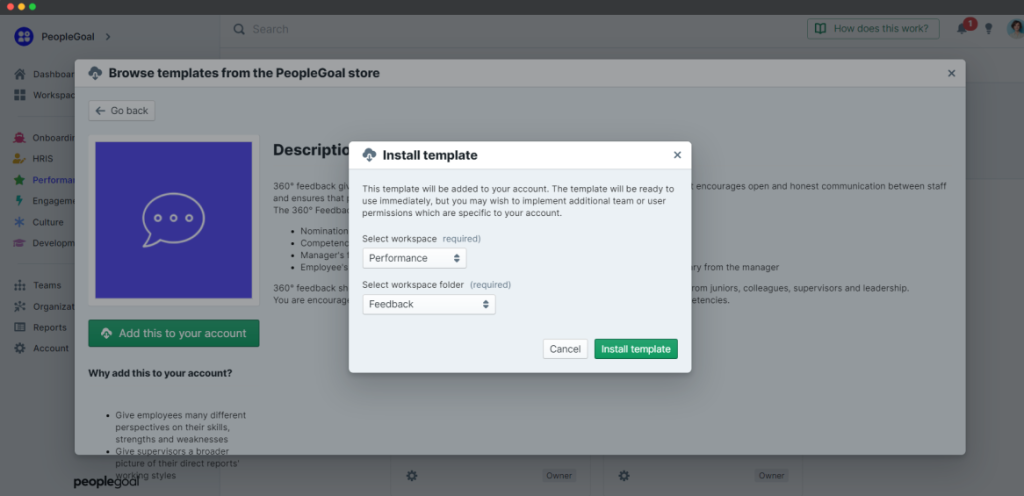
Step 2: Customize the Feedback Form
If you want to tweak the template to fit your process, you can easily edit, add, remove, or reorder questions and sections. Keep what works, remove what doesn’t, and tailor the language to reflect your team’s style.
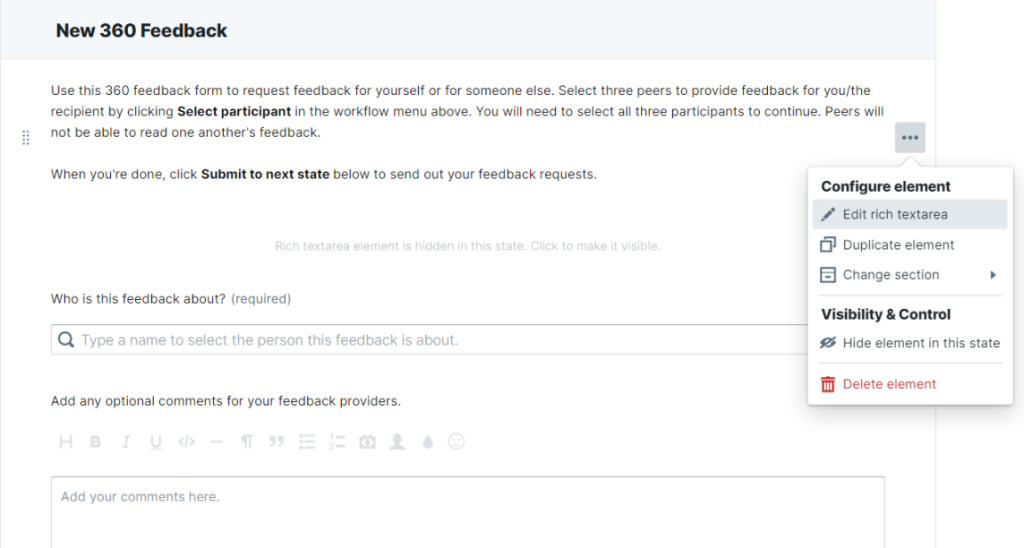
Step 3: Configure Workflow and Visibility
Use the workflow builder to define who gives feedback, who receives it, and what each person can see. You can keep the flow simple or add multiple steps, depending on your process. Adjust visibility settings so the right people have access at the right time.

Step 4: Add Participants and Launch
Assign the people involved in the feedback cycle. You can let employees start their own requests or have managers initiate them. Set default relationships like “Manager” or “Team Lead” to make future cycles easier to launch.
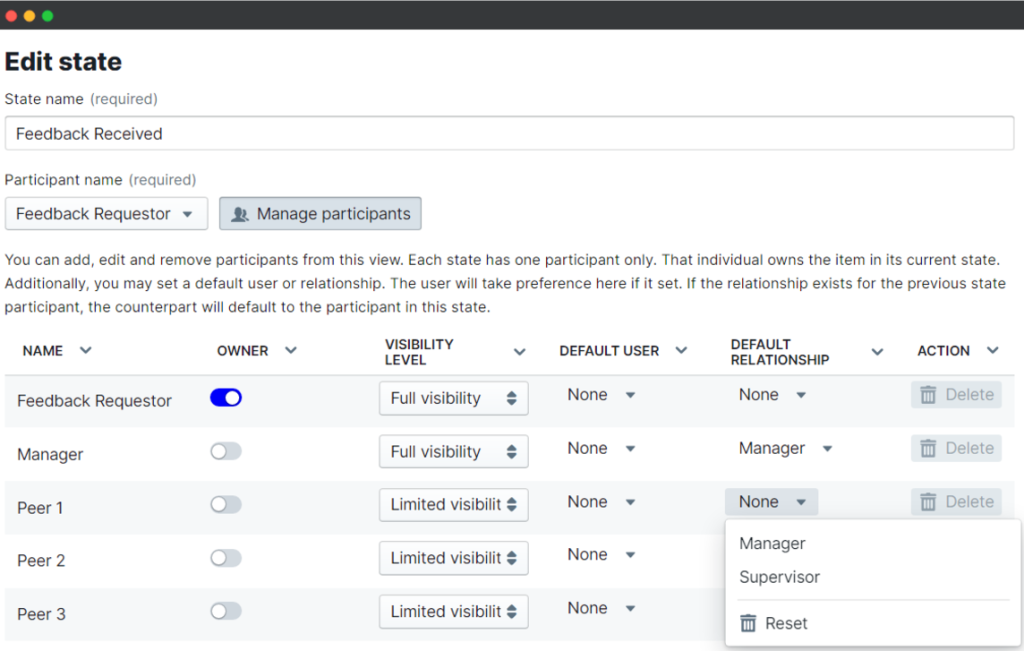
Step 5: Set Permissions and Automate
Decide who can create, view, or edit feedback. You can set permissions by user, role, or team. Once permissions are in place, your workflow is ready to run on autopilot, with everything tracked and organized in one place.
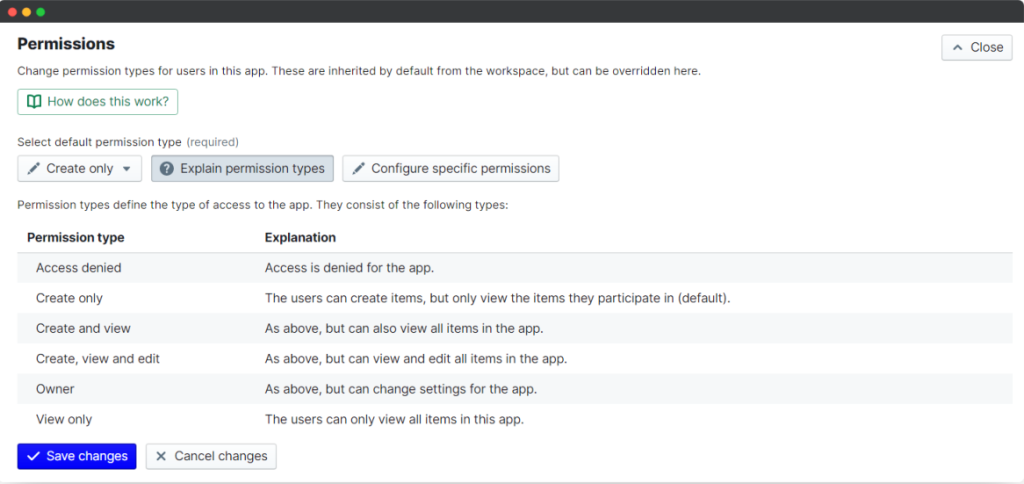
And that is!
This is how you use continuous feedback tools to deliver feedback that actually works.
Here’s a quick video to help you get started with continuous 360-degree feedback:
But post this, you need to analyze the performance of the continuous performance feedback process you developed. The next section will offer you a better idea.
How to Measure the Impact of Continuous Feedback
You’ve put a system in place. You’ve trained your managers. Feedback is happening. But here’s the big question: Is it working?
If you want your continuous feedback model to be more than just a good idea, you have to measure its impact on your people, your performance, and your culture.
That doesn’t mean obsessing over every data point, but it does mean keeping your eyes on the signals that show whether your feedback process is truly driving improvement.
Here’s how I recommend you measure it in the real world.
1. Track Participation and Feedback Frequency
One of the first things I check with any feedback system is usage. Because if it’s not being used, it’s not doing anything.
Ask yourself:
- Are managers regularly giving feedback?
- Are employees receiving input more than once or twice a year?
- Are one-on-ones happening when they’re scheduled?
Let’s say you rolled out a new process where managers are expected to provide written feedback monthly.
If you’re seeing participation drop after month two, you know the system isn’t sticking. On the other hand, if 85% of your managers are maintaining the rhythm by month six, that’s a sign of cultural adoption.
What to track:
- Total feedback entries submitted each month
- Number of active users (managers and employees)
- Frequency of 1:1 meetings logged in your system
This helps you spot who’s engaged and where you need to provide reminders, coaching, or accountability.
2. Monitor Goal Progress and Completion Rates
Continuous feedback isn’t just about praise or critique; it should help people stay aligned and on track.
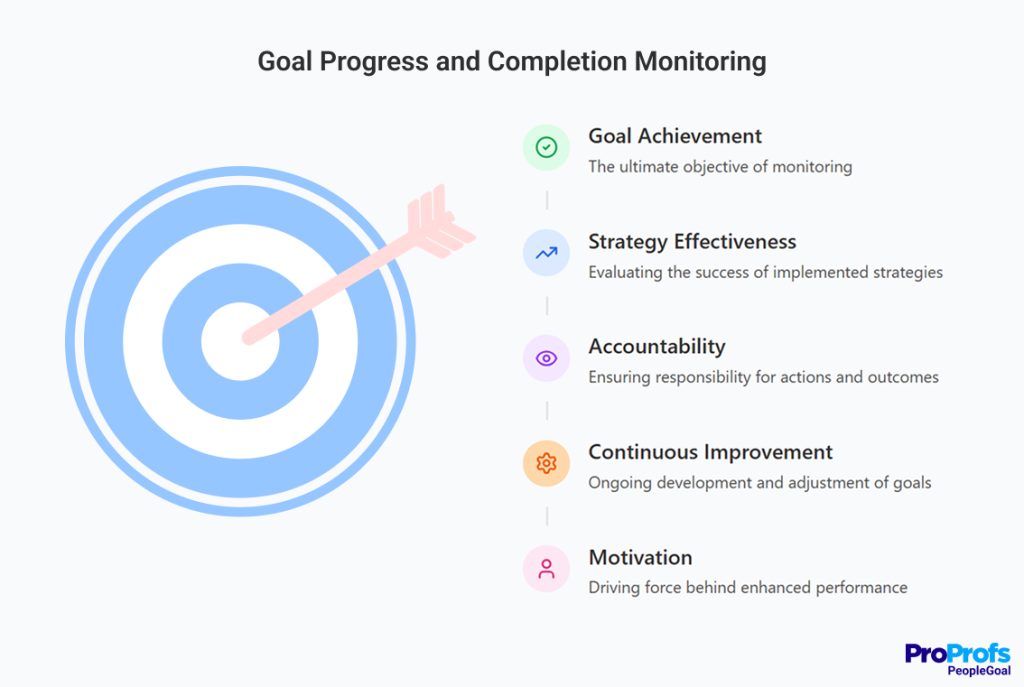
If you’re using feedback to reinforce OKRs or individual goals, you should see a measurable improvement in how fast and how well those goals are being completed.
Let’s say your product team has a quarterly goal to improve app load speed. Feedback should help identify blockers early, adjust priorities mid-cycle, and celebrate momentum at each milestone. If goals are being discussed weekly but still not achieved, there’s likely a gap between feedback and execution. This is where continuous feedback performance management becomes crucial, ensuring that insights shared during check-ins lead to real action and measurable progress.
What to track:
- Percentage of goals completed on time
- Frequency of goal updates or discussions
- Mid-cycle goal realignment (if priorities change)
If feedback isn’t moving goals forward, it’s either not specific enough or not tied back to the work.
3. Compare Employee Engagement Over Time
The best feedback systems do more than manage performance; they help people feel seen, supported, and motivated.
Engaged employees are more productive and more loyal. If your feedback process is working, you should see improvement in how people respond to engagement questions like:
- “I receive regular feedback that helps me grow.”
- “I have clear expectations about my role and goals.”
- “My manager listens and supports me.”
I once worked with a team where engagement around growth and development jumped 22% within one quarter of adopting regular check-ins.
The conversations didn’t need to be long; they just needed to be consistent and meaningful.
What to track:
- Pulse survey results (monthly or quarterly)
- Changes in eNPS (Employee Net Promoter Score)
- Feedback-specific questions in engagement surveys
If engagement goes up after feedback increases, you’re on the right track.
4. Analyze Retention and Exit Feedback
When people leave your company, you should know whether feedback, or lack of it, played a role.
If top performers are exiting and citing things like “unclear expectations” or “no development path,” that’s a red flag. You may think feedback is happening, but clearly it’s not landing where it counts.
Compare retention trends before and after you rolled out a continuous feedback model. For example, if turnover was 24% in the year before and drops to 17% six months in, that’s strong evidence of impact, especially if the drop is highest among teams with active managers.
What to track:
- Voluntary turnover rates by department or manager
- Exit interview themes (mention of feedback, manager support, clarity)
- Average tenure for high-performing employees
Retention is where the real ROI of feedback shows up, because it’s much cheaper to coach and retain than to replace and rebuild.
5. Evaluate Manager Effectiveness
Let’s be honest: continuous feedback lives or dies with your managers. Some will lead with it naturally. Others need a nudge (or a lot of structure).
If you want to know which managers are truly supporting their teams, feedback data will tell you.
You might find that one manager has perfect retention and high-performing employees, but barely submits feedback. That might mean they’re giving it in person, or it might mean their team is surviving despite a lack of support.
On the flip side, a new manager consistently logging thoughtful feedback and holding regular 1:1s could be building a powerhouse team in the making.
What to track:
- Feedback frequency per manager
- 1:1 consistency and duration
- Upward feedback from employees (if collected)
You can even run a report showing which teams are receiving the most timely feedback, and then ask their leaders to share their habits with others.
6. Review Performance and Growth Trends
When feedback is working, performance improves. Not just in review scores, but in how people show up day-to-day.
You might notice that employees who used to struggle with time management are now hitting deadlines. Or that project outcomes are smoother because roles and expectations were clarified in advance. This kind of improvement is easy to miss unless you’re tracking it.

Look across quarters or projects to compare:
- Individual performance ratings or review trends
- Peer recognition data (who’s being called out and why)
- Promotion velocity or role readiness
If feedback is helping people grow faster and perform better, you’ll see it in how quickly they level up and how often they’re called on for bigger work.
7. Ask for Feedback on the Feedback Process
Finally, don’t assume your system is working just because it exists. Ask your people what’s helpful and what isn’t.
I’ve had teams tell me, “The questions are fine, but they feel too formal,” or “We’d love more space for open-ended input.” That kind of feedback helped us simplify the process and make it feel more natural without reducing quality.
You can gather input through:
- Short internal surveys about the feedback experience
- Open-ended questions in one-on-ones
- Team retros or debriefs after a full cycle
Questions like these help:
- “Do you feel like the feedback you receive is timely and useful?”
- “What could we do to make the process easier or more helpful?”
- “Is there a better way we could structure the conversations?”
This isn’t just about UX—it’s about showing your people that continuous improvement applies to culture, not just performance.
Build a Feedback Culture That Scales, Sticks & Works
Continuous feedback isn’t just some feel-good HR trend; it’s one of the most practical, performance-driven habits you can build into your team culture.
When feedback is regular, specific, and human, you get fewer surprises, faster growth, and stronger alignment across the board. You don’t need a complicated process, you just need consistency, structure, and the right mindset.
Here’s what continuous feedback gets you:
- Clearer direction, without waiting for the review season
- Real-time coaching that actually sticks
- Recognition when it matters most (not six months later)
- A culture where growth feels normal, not personal
But here’s the catch: feedback falls apart when it’s inconsistent or undocumented. That’s where tools like PeopleGoal make all the difference. You can automate workflows, track what matters, and keep the process smooth without losing the human touch.
If you want your feedback culture to scale and stick, don’t just wing it. Build it right from day one.
Frequently Asked Questions
1. How often should continuous feedback be given?
There’s no one-size-fits-all answer, but a good rhythm is once or twice a month. For fast-paced teams, weekly works better. What matters most is that feedback feels consistent and expected, not random. The goal is to keep people informed, aligned, and supported throughout their work.
2. Can continuous feedback replace annual performance reviews?
In many organizations, it absolutely can. Continuous feedback handles most of the core needs like coaching, recognition, and alignment. However, some still run an end-of-year wrap-up to reflect on growth and set new goals. Think of continuous feedback as the system that feeds into smarter, more useful reviews.
3. What if my managers aren’t giving quality feedback?
You’re not alone. Most managers have never been formally trained on how to give good feedback. Start small with clear examples and structured prompts. Tools like PeopleGoal include ready-to-use templates and workflows that guide managers through the process. The more support you provide, the faster they build confidence and skill.
4. How do I keep continuous feedback from overwhelming my team?
The key is focus and timing. Feedback should be useful, not constant. Aim to give input when it helps clarify goals, improve performance, or recognize effort. With tools like PeopleGoal, you can automate cycles, space them out appropriately, and make feedback feel like a rhythm, not a burden.
5. Is continuous feedback suitable for remote teams?
Yes, and in many cases, it’s even more essential. Remote employees don’t get the benefit of casual check-ins or nonverbal cues, so structured feedback fills the gap. Platforms like PeopleGoal make it easy to stay connected through regular input, even when your team is fully distributed.
Ready to 3x Your Teams' Performance?
Use the best performance management software to align goals, track progress, and boost employee engagement.


